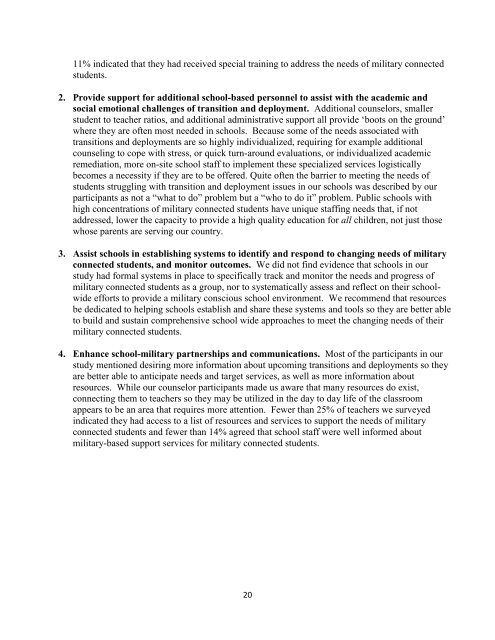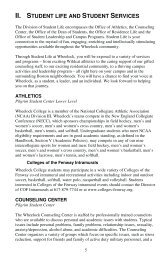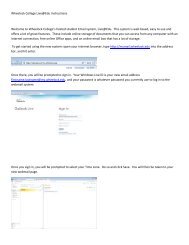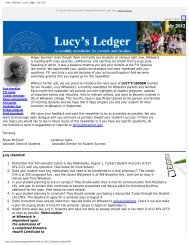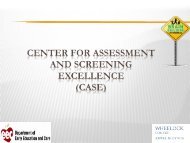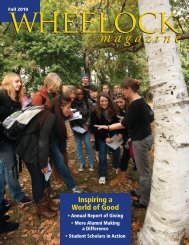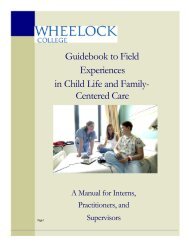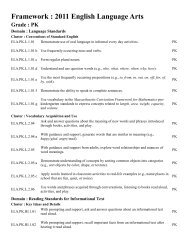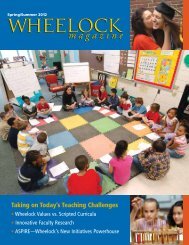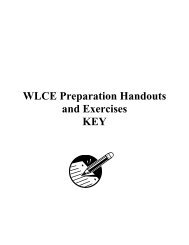students who have less support at home due to <strong>the</strong> deployment of a parent must be structured anddelivered by school staff. Teachers, principals, counselors and o<strong>the</strong>r school staff must collaborate toestablish responsive classroom and school settings to meet <strong>the</strong> social and emotional needs of studentsstruggling with transition and deployment related stressors, as well as provide additional counselingservices to <strong>the</strong>se students.Many of <strong>the</strong> educators we interviewed expressed a desire to establishing communications withparents and <strong>the</strong> military in order to find out as much information as possible about upcoming transitionsand deployments, so <strong>the</strong>y are able to know which students may need which service and when.Educators also described how <strong>the</strong>y struggled with creating and recreating schedules and classarrangements that work in <strong>the</strong> context of a shifting, difficult-to-predict population of students. Someasked questions about how to assess and track <strong>the</strong> needs of military connected students in order toinvestigate whe<strong>the</strong>r and how programs and service provided are being used.Schools’ ability to address <strong>the</strong>se issues and promote student wellbeing and academic progress isintimately connected to <strong>the</strong> ways schools do business. Supportive school communities are not likely tobe developed solely through externalized or add-on programs and supports without concomitant changeat <strong>the</strong> school level. There is <strong>the</strong>refore a need to build capacity within schools to meet <strong>the</strong> needs ofmilitary connected students. Although external programs and resources can be beneficial, <strong>the</strong>y requireinternalized structures and supports to be able to take root and become part of <strong>the</strong> life and institutionalmemory of <strong>the</strong> school. Fur<strong>the</strong>rmore, limited funding availability makes it imperative to empowerschools and school personnel to maximize <strong>the</strong>ir own resources to meet <strong>the</strong> needs of military connectedstudents.Sustainability is possible if capacity is built simultaneously inside-out and outside-in (Bol,Nunnery, & Low<strong>the</strong>r, 1998). With this in mind, our recommendations for <strong>the</strong> Department of Defenseand o<strong>the</strong>rs seeking to enhance school responsiveness to <strong>the</strong> specific needs of military connected childrenare:1. Provide sustained, comprehensive, job embedded professional development for school staffwho work with military connected students to create <strong>the</strong> capacity for building school-wideprograms and practices that meet <strong>the</strong> academic and social-emotional needs of militarystudents and families. The impacts of transition and deployment are realized at <strong>the</strong> school,classroom and individual levels. Accordingly, staff who work with military connected studentsat all <strong>the</strong>se levels—namely administrators, teachers and o<strong>the</strong>r instructional staff, and counselorsand o<strong>the</strong>r support service providers—must be aware of and able to address <strong>the</strong> educational needscreated by transition and deployment. Fur<strong>the</strong>rmore, this training must extend beyond <strong>the</strong> simpleawareness of issues and equip professionals with <strong>the</strong> methods and tools <strong>the</strong>y need to be able tocreate and implement <strong>the</strong> academic and social-emotional supports needed by <strong>the</strong>ir studentscoping with transition and deployment related issues. Teachers, administrators, counselors ando<strong>the</strong>r school staff will be assisted in creating classrooms and schools in which all militaryconnected students can succeed by equipping <strong>the</strong>m with a repertoire of tools, exemplars andmodels <strong>the</strong>y can use in <strong>the</strong>ir actual job capacities, time to explore <strong>the</strong>m, assistance withimplementation of <strong>the</strong>se tools, and <strong>the</strong> construction of customized tools that fit <strong>the</strong>ir own localschool contexts. According to <strong>the</strong> participants in our <strong>study</strong>, this sort of assistance would likelybe well received and utilized at this time. Over 80% of <strong>the</strong> teachers we surveyed indicated that itis a priority for <strong>the</strong>m to learn more about <strong>the</strong> needs of military connected students while only19
11% indicated that <strong>the</strong>y had received special training to address <strong>the</strong> needs of military connectedstudents.2. Provide support for additional school-based personnel to assist with <strong>the</strong> academic andsocial emotional challenges of transition and deployment. Additional counselors, smallerstudent to teacher ratios, and additional administrative support all provide ‘boots on <strong>the</strong> ground’where <strong>the</strong>y are often most needed in schools. Because some of <strong>the</strong> needs associated withtransitions and deployments are so highly individualized, requiring for example additionalcounseling to cope with stress, or quick turn-around evaluations, or individualized academicremediation, more on-site school staff to implement <strong>the</strong>se specialized services logisticallybecomes a necessity if <strong>the</strong>y are to be offered. Quite often <strong>the</strong> barrier to meeting <strong>the</strong> needs ofstudents struggling with transition and deployment issues in our schools was described by ourparticipants as not a “what to do” problem but a “who to do it” problem. Public schools withhigh concentrations of military connected students have unique staffing needs that, if notaddressed, lower <strong>the</strong> capacity to provide a high quality education for all children, not just thosewhose parents are serving our country.3. Assist schools in establishing systems to identify and respond to changing needs of militaryconnected students, and monitor outcomes. We did not find evidence that schools in our<strong>study</strong> had formal systems in place to specifically track and monitor <strong>the</strong> needs and progress ofmilitary connected students as a group, nor to systematically assess and reflect on <strong>the</strong>ir schoolwideefforts to provide a military conscious school environment. We recommend that resourcesbe dedicated to helping schools establish and share <strong>the</strong>se systems and tools so <strong>the</strong>y are better ableto build and sustain comprehensive school wide approaches to meet <strong>the</strong> changing needs of <strong>the</strong>irmilitary connected students.4. Enhance school-military partnerships and communications. Most of <strong>the</strong> participants in our<strong>study</strong> mentioned desiring more information about upcoming transitions and deployments so <strong>the</strong>yare better able to anticipate needs and target services, as well as more information aboutresources. While our counselor participants made us aware that many resources do exist,connecting <strong>the</strong>m to teachers so <strong>the</strong>y may be utilized in <strong>the</strong> day to day life of <strong>the</strong> classroomappears to be an area that requires more attention. Fewer than 25% of teachers we surveyedindicated <strong>the</strong>y had access to a list of resources and services to support <strong>the</strong> needs of militaryconnected students and fewer than 14% agreed that school staff were well informed aboutmilitary-based support services for military connected students.20


